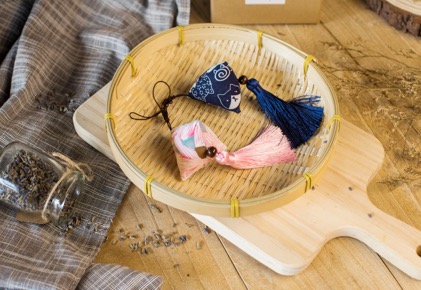糖画Sugar Painting
糖画是一种传统民间手工艺,主要以糖为材料来进行造型。做法是将糖放在炉子上用温火熬制,熬到可以牵丝时即可以用来浇铸造型。糖画据传起源于明朝,中国民间艺术家将糖模型与皮影戏、剪纸等其他艺术结合起来,创造出多样化的图案。为了继承和发展这种艺术和食品,政府将其列为省级非物质文化遗产。制作糖画有四个步骤,先是煮糖浆,然后在一个平面上绘画,随后将其粘于木棍,最后从平面上取出。2012年,市场上出现了糖画制作机器,将糖放入机器后,它就会自动在一个平面上作画,整个制作过程操作简单。
Sugar painting is a form of traditional Chinese folk art using hot, liquid sugar to create two dimensional objects on a marble or metal surface. After the sugar cools, it will be stick to a bamboo stick and removed using a spatula. Three dimensional objects can be created by laying solidified sugar. Sugar painting may have originated during the Ming dynasty when aristocratic families or government officials molded small animals made of sugar for religious rituals. As techniques improved, Chinese folk artists combined the molded sugar with other arts, like shadow play and paper cutting, to create a more diverse range of patterns.
Nowadays, sugar painting is considered as a representation of the wisdom and creativeness of Chinese people. To inherit and develop this kind of art and food, the government listed it as Provincial Non-Material Culture Heritage.
The process of sugar painting includes four steps, including boiling down syrup, painting on a plane, sticking to a stick, removing from the surface.
In 2012. automatic machines for making sugar paintings started to appear in the market. Once sugar is added, the machine is programmed to paint on a surface in a process similar to automatic engraving. It does not need any art skills or experience, and is easy to operate.
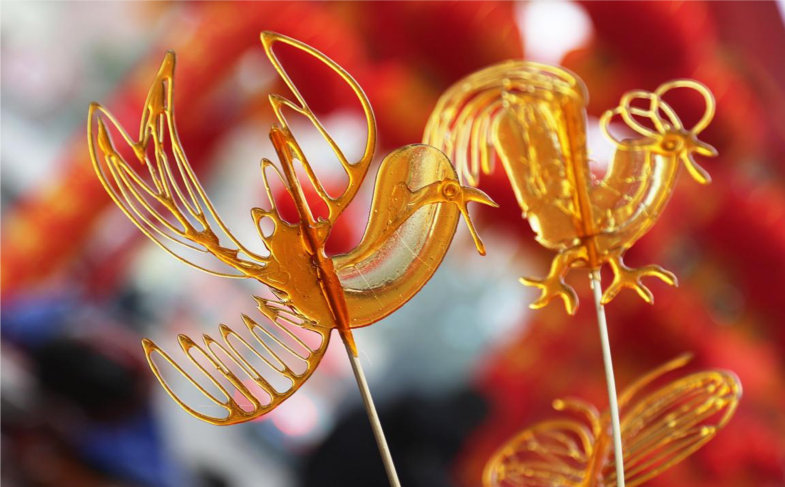
剪影Silhouette Portrait
剪影是剪纸形式的一种,运用剪刀和黑色纸(或重色纸)剪制人物、动物或其它物体的典型外轮廓,无内部结构,并通过影的造型表现形象。剪影的最初产生,据说是欧洲皇族为了记录他们的御容,除了用各种绘画的方法之外,还创造了剪影。它于1928年传入中国,并流传至今。
Silhouette portrait is a form of paper-cutting art. Scissors and black paper (or dark color paper) are used to cut the external contour of people, animals or objects without internal structure, and the image is showed by the shape of the shadow.
Silhouette portrait was introduced into China in 1928. The origin of it is said to be one of the artworks in European ruling houses. In order to portrait the features of royal families, royal artists created silhouette portraits in addition to various painting methods to meet their requirements.
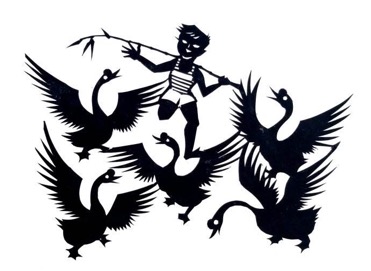
捏面人Dough Figurine
捏面人的起源可以追溯到17世纪,是中国传统的儿童玩具,是用面团或糯米粉做成的动物、花卉、民间故事中的人物等可食用的小雕像。
制作面人需要糯米粉和普通米粉的混合物。过去,面人是揉搓后蒸制而成,而现在是由煮熟的面糊做成,可以减少制作的时间。
Dough figurine is a traditional Chinese toy originated in 17thcentury which is made from dough or glutinous rice powder in form of edible figurine such as animals, flowers or characters in folk stories. The toy is introduced in almost all traditional festivals and public places like parks or gardens.
To create a dough figurine, the craftsman needs a mixture of glutinous and ordinary rice powders which is easily to knead into different shapes and edible for children. In the past, dough figurine was steamed after being kneaded but today they are made directly from pre-boiled paste so that the craftsman can reduce the time for making one figurine.
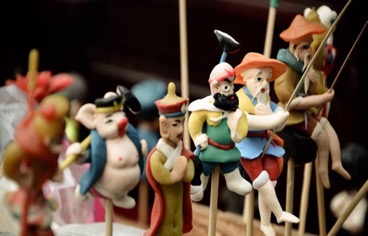
皮影戏Shadow Play
皮影戏,又称影子戏或灯影戏,是将皮影人置于光源与半透明屏幕或布帘间,用以叙说故事及娱乐的传统表演艺术。1235年的一本书提到,皮影人最初是用纸剪的,但后来改用彩色皮革或羊皮纸制成。民间制作皮影的基本步骤包括刮、磨、洗、刻、著色等共二十四道工序。皮影人约750px高,多为侧面形像,外形轮廓以线条简洁、平滑流畅为主。皮影戏演出的关键,在于操控技巧和唱功,内容包括历史事迹、虚构作品还有喜剧。
Shadow play, also known as shadow puppetry, is an ancient form of storytelling and entertainment which uses flat articulated cut-out figures (shadow puppets) which are held between a source of light and a translucent screen or scrim. Various effects can be achieved by moving the puppets and light source.
A 1235 book mentions that puppets were initially cut out of paper, but later made of colored leather or parchment. There are 24 steps of making shadow puppets including scraping, grinding, washing, carving and coloring, etc. They are about 750px high, mostly in profile, with simple and smooth outline.
The stories are mostly true, but some are fictional and comic.
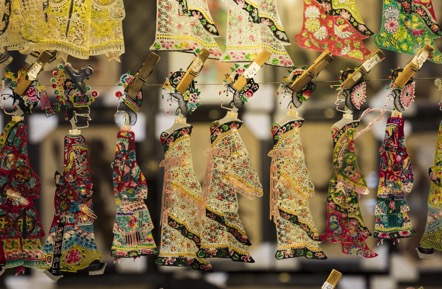
灯谜Lantern Riddles
灯谜,是北宋时期兴起的习俗,每年逢正月十五元宵节结合赏花灯进行。玩法是将谜语贴在灯上,猜中谜语的人,有时可获得奖品,多数谜语都是诗词。
Lantern riddles, got popular since earlier Song Dynasty, often accompanied with flower lanterns on the 15th Lantern Festival of the first month every year as a guessing game that many people can participate in together. The rule is to stick riddles on the lamp, most of them are poems, the person figures out the riddles may get prizes.
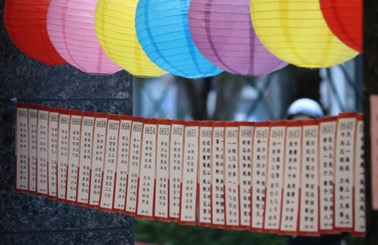
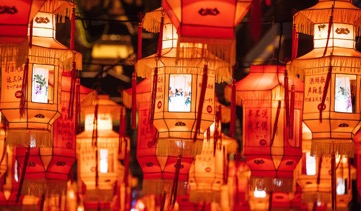
冰糖葫芦Bingtanghulu (Skewers of glazed fruit)
冰糖葫芦是中国传统小吃,它是将野果用竹签串成串后蘸上麦芽糖稀,糖稀遇风迅速变硬。制作糖葫芦须先将山楂洗净、煮熟,去除果核,用竹签穿成串;将绵白糖加水熬化,用果串在糖中一蘸,然后静置冷却即可。
Tanghulu, also called Bingtanghulu, is a traditional Northern Chinese snack of candied Crataegus pinnatifida. It consists of fruits covered in hard candy on bamboo skewers which are approximately 20 cm long, they are coated in a hardened sugar syrup.To make a traditional Bingtanghulu, the first thing is to boil the cleaned hawthorns, then remove the core, and boil the soft white sugar. After the sugar is boiled, dip the fruit string in the sugar and leave it to cool.
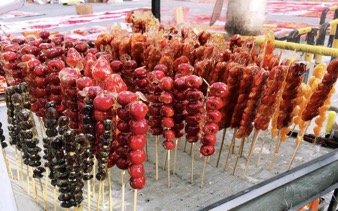
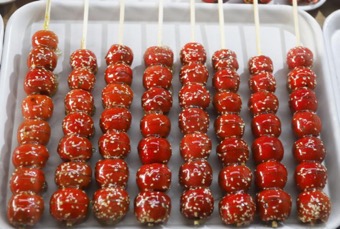
汉服Han Chinese Clothing
汉服是指中国历史上的服饰样式,汉族人穿长袍或衬衫作上装,而下装通常是褶裥裙。传统汉服包括了中国汉族的所有传统服装分类,有记录的历史超过三千年,直到明朝末年为止。一套汉服由衣、袍、襦、衫、裙(裳)、裤部分组成。
Ancient Chinese clothing refers to the historical clothing styles of China. The Han Chinese historically wore a robe or a shirt for the upper garment, while the lower garment was commonly a pleated skirt.
Traditional Han clothing comprises all traditional clothing classifications of the Han Chinese with a recorded history of more than three millennia until the end of the Ming Dynasty.
A complete set of Han Chinese garment is assembled from several pieces of clothing into an attire:
Yi (衣)、Pao (袍)、Ru (襦)、Shan (衫)、Qun (裙) 、Ku (褲)
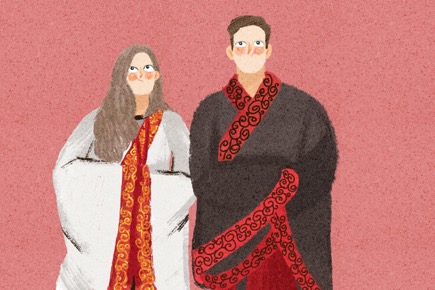
中国结Chinese Knotting
中国结是一种装饰性手工艺品,始于唐宋时期,后来在明朝推广,并传播到日本和韩国。中国结由线或绳编成,把不同的结饰互相结合在一起,或用其他具有吉祥图案的饰物搭配组合,就形成了中国结。中国结通常是系索式的,将两条绳从结的顶部进入,然后从底抽出开,一般是双层且对称的。线的色彩以中国红最为常见。
Chinese knotting is a decorative handicraft art that began as a form of Chinese folk art in the Tang and Song dynasty. The technique was later popularized in the Ming and spread to Japan and Korea.
Chinese knot is formed by combining different knot decorations with each other or using other decorations with auspicious patterns to express blessings or prayers.
Chinese knots are usually lanyard type arrangements where two cords enter from the top of the knot and two cords leave from the bottom. The knots are usually double-layered and symmetrical. As for the color of the line, red are the most common.
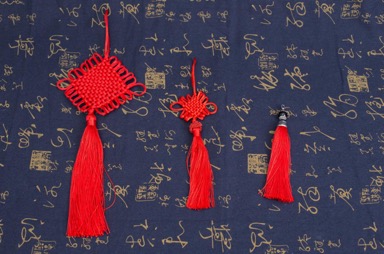
香囊Sachet
香囊是一个小的有香味的布袋,里面装满了香草、百花或其他芳香成分。战国时期,香囊是戴在身上用来吸汗的装饰品,以此驱虫辟邪。唐宋时期,其逐渐成为女性用的物品,到了清代又成为了一种爱情信物。香囊通常是自制的,有很多大小,样式,形状和香味。将其放入衣服内不仅能使衣服闻起来香甜,而且能驱虫。有些甚至制成香囊项链,还有些用刺绣、珠子、纽扣、丝带等花哨的布料装饰。
A sachet is a small scented cloth bag filled with herbs, potpourri or aromatic ingredients.
During the Chinese Warring States period, a scented sachet was an ornament worn on the body and used to absorb sweat, repel insects and ward off evils. Since around the Tang Dynasty and Song Dynasty, scented bags were preferred only by women.Hundreds of years later, it became a love token in the Qing Dynasty.
Scented sachets are often homemade and come in many sizes, styles, shapes and fragrances. They are not only used to make garments sweet smelling but keep away destructive insects and worms. Some are even made into Sweet Bag necklaces. Some are decorated with embroidery, beads, buttons, ribbons, and fancy cloth.
